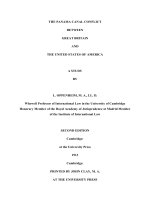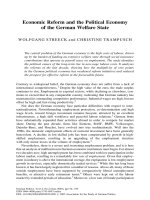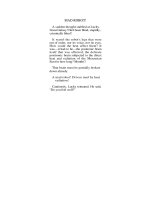selfless insight zen and the meditative transformations of consciousness mar 2009
Bạn đang xem bản rút gọn của tài liệu. Xem và tải ngay bản đầy đủ của tài liệu tại đây (3.85 MB, 371 trang )
SELFLESS INSIGHT
Z n and the Meditati e
Transformations
of Con ciousness
J mes H. Aust n, M.D.
Selfless Insight
The MIT Press
Cambridge, Massachusetts
London, England
Selfless Insight
Zen and the Meditative Transformations of Consciousness
James H. Austin, M.D.
( 2009 Massachusetts Institute of Technology
All rights reserved. No part of this book may be reproduced in any form by any electronic or mechani
cal means (including photocopying, recording, or information storage and retrieval) without permis
sion in writing from the publisher.
MIT Press books may be purchased at special quantity discounts for business or sales promotional use.
For information, please e mail special or write to Special Sales Department,
The MIT Press, 55 Hayward Street, Cambridge, MA 02142.
This book was set in Palatino and Frutiger on 3B2 by Asco Typesetters, Hong Kong and was printed
and bound in the United States of America.
Library of Congress Cataloging in Publication Data
Austin, James H., 1925
Selfless insight : Zen and the meditative transformations of consciousness / James H. Austin.
p. cm.
Includes bibliographical references and index.
ISBN 978 0 262 01259 1 (hardcover : alk. paper) 1. Meditation Zen Buddhism. 2. Zen Buddhism
Psychology. 3. Consciousness Religious aspects Zen Buddhism. I. Title.
BQ9288.A95 2009
294.3
0
4435 dc22 2008026983
10987654321
Also by James H. Austin
Zen-Brain Reflections (2006)
Chase, Chance, and Creativity (2003)
Zen and the Brain (1998)
To my early teachers Nanrei Kobori-Roshi, Myokyo-ni, and Joshu Sasaki-Roshi,
for inspiration; and to all those whose contributions to Zen, and to the brain, are
reviewed in these pages.
Your true self is free from beauty and ugliness, free from God and evil.
When you manifest yourself as emptiness, at that moment, you are free
from everything.
Joshu Sasaki-Roshi (1907– )
Contents in Brief
Contents in Detail xiii
Chapters Containing Testable Hypotheses xvi
List of Figures xviii
List of Tables xix
Preface xx
Acknowledgments xxiii
By Way of Introduction xxiv
Part I On the Varieties of Attention 1
Part II On the Origins of Self 49
Part III Toward Selflessness 85
Part IV On the Nature of Insight 123
Part V On the Path toward Insight-Wisdom 189
Part VI Toward Emotional Maturity 221
Part VII Updating Selected Research 249
In Closing 268
Glossary 270
References and Notes 274
Source Notes 313
Index 315
Contents in Detail
Contents in Brief xiii
Chapters Containing Testable Hypotheses xvi
List of Figures xviii
List of Tables xix
Preface xx
Acknowledgments xxiii
By Way of Introduction xxiv
Part I On the Varieties of Attention 1
1 Training Attention 3
2 Meditating Mindfully at the Dawn of a New Millennium 8
3 Meditation: ‘‘JUST THIS’’ 11
4 Neurologizing about Attention 14
5 On Remaining Attentive while We Meditate 21
6 Perceiving Clearly 27
7 Network Systems Serving Different Forms of Attenti on 29
8 The Implications of Training More Efficient Attentional
Processing 35
9 Studying Meditators’ Brains 39
10 Inward Turned Attention: Induced Experiences 43
11 First Mondo 47
Part II On the Origins of Self 49
12 You Are the ‘‘Person of the Year’’ 51
13 On the Nature and the Origins of the Self 53
14 Selective Deficits of Egocentric or Allocentric Processing in
Neurological Patients 64
15 The Brain’s Active Metabolism during Resting Conditions 70
16 Internal ‘‘Mirrors’’ Facing Outward 76
17 Subcortical Contributions to Self/Other Distinctions 79
18 Second Mondo 81
Part III Toward Selflessness 85
19 Seeing Selflessly in a New Dimension 87
20 On the Long Path toward Selflessness 95
21 Neuroimaging during Tasks That Shift the Brain from Self-
Referential into Other-Referential Forms of Attention 98
22 Slow Fluctuations, Revealing How Networks Shift
Spontaneously 103
23 The Balance of Opposing Functions: Age-Old Perspectives and
the Destabilizing Effect of Triggers 109
24 Third Mondo 118
Part IV On the Nature of Insight 123
25 Intuitions about Insight 125
26 A Lotus Puzzle 129
27 Our Normal Quest for Meaning 130
28 Studies of Meaningful Coherence in Visual Images 135
29 Dynamic Aspects of Truth 141
30 Value Systems for Truth, Beauty, and Reality 143
31 The Temporal Lobe: Harmonies of Perception and Interpretation 146
32 The Temporal Lobe: Word Thoughts Interfere with No-Thought
Processing 150
33 The Pregnant Meditative Pause: Introspection; Incubation 153
34 Recent, Ongoing Neuroimaging Studies of Ordinary Forms of
Insight 158
35 Alternative Ways to Study Ordinary Insight Using
Neuroimaging Techniques 169
36 Does Eliminating the Negative Help to Accentuate the
Positive? 173
37 Balancing One’s Assets and Liabilities 180
38 Fourth Mondo 186
Part V On the Path toward Insight-Wisdom 189
39 The Broken Water Bucket 191
40 The Construction and Dissolution of Time 193
41 Aspects of Wisdom 197
42 Cutting into the Layers of Self 199
43 Striking at the Roots of Overconditioned Attitudes 202
44 Neuroimaging Our Representations of Shoulds and Oughts 207
45 Distinctions between Intuitive Mind Reading, Simple Empathy,
and Compassion 211
xiv Contents in Detail
46 Empathy, Forgivability, and the Responses of the Medial
Prefrontal Cortex 213
47 Rigorous Retreats, and the Supporting Influence of a Friendly
Hand 215
48 Show Me 217
49 Fifth Mondo 219
Part VI Toward Emotional Maturity 221
50 On Learning about the Emotions 223
51 Modulating the Emotions 223
52 How Could the Long-Term Meditative Path Modulate the
Emotions? 228
53 Newer Views of Extinction 233
54 Anatomical Asymmetries: Autonomic, Emotional, and
Temperamental Implications 235
55 The Cognitive and Emotional Origins of Maturity 237
56 Brain Peptides Help Decode Subtle Facial Emotions 244
57 Did You Really ‘‘Have a Good Day?’’ 246
58 Sixth Mondo 247
Part VII Updating Selected Research 249
59 Selected Topics of Current Interest: A Sample 251
In Closing 268
Glossary 270
References and Notes 274
Source Notes 313
Index 315
Contents in Detail xv
Chapters Containing Testable Hypotheses
It is better to know some of the questions than all of the answers.
James Thurber (1894–1968)
The outcome of any serious research can only be to make the two questions grow
where only one grew before.
Thorstein Veblen (1857–1929)
These chapters suggest potential correlates between brain functions, meditative
training, and the phenomena of alternate states of consciousness.
4 Neurologizing about Attention 14
8 The Implications of Training More Efficient Attentional Processing 35
9 Studying Meditators’ Brains 39
15 The Brain’s Active Metabolism during Resting Condi tions 70
20 On the Long Path toward Selflessness 95
22 Slow Fluctuations, Revealing How Networks Shift Spontaneously 103
23 The Balance of Opposing Functions: Age-Old Perspectiv es and the
Destabilizing Effect of Triggers 109
24 Third Mondo 118
25 Intuitions about Insight 125
28 Studies of Meaningful Coherence in Visual Images 135
30 Value Systems for Truth, Beauty, and Reality 143
31 The Temporal Lobe : Harmonies of Perception and Interpretation 146
34 Recent Ongoing Neuroimaging Studies of Ordinary Forms of Insight 158
37 Balancing One’s Assets and Liabilities 180
40 The Construction and Dissolution of Time 193
43 Striking at the Roots of Overconditioned Attitudes 202
46 Empathy, Forgivability, and the Responses of the Medial
Prefrontal Cortex 213
51 Modulating the Emotions 223
52 How Could the Long-Term Meditative Path Modulate the Emotions? 228
55 The Cognitive and Emotional Origins of Maturity 237
56 Brain Peptides Help Decode Subtle Facial Emotions 244
Chapters Containing Testable Hypotheses xvii
List of Figures
Figure 1 Lateral view of the left hemisphere 24
Figure 2 Medial view of the right hemisphere 25
Figure 3 Lateral view of the right hemisphere 33
Figure 4 Directions of the two streams in a lateral view of the left
hemisphere 60
Figure 5 Directions of the two streams in a medial view of the right
hemisphere 61
Figure 6 Thalamocortical contributions to the dorsal egocentric and
ventral allocentric streams 88
Figure 7 The dual effect of a triggering stimulus: a hypothesis for the
precipitation of kensho 114
List of Tables
Table 1 The Attentive Art of Meditation 4
Table 2 Two Types of Event-Related Gamma Wave Responses 17
Table 3 Frontal and Parietal Aspects of Paying Visual Attention 18
Table 4 Representations and Responses of the Dorsal and Ventral
Attention Systems 31
Table 5 Relationships between Different Types of Attention and the
Major Forms of Meditation 40
Table 6 Examples of Ego/Allo Terminology 57
Table 7 The Two Major Processing Streams 63
Table 8 Hemispheric Differences in Self/Other Processing 70
Table 9 Decoding Functions That Correlate with Particular Proces sing
Regions 137
Table 10 Complementary Aspects of Hemispheric Processing When
Subjects Derive Inferences from Simple Texts 151
Table 11 Complementary Aspects of Hemispheric Processing When
Ordinary Problems Are Solved by Insight 160
Table 12 Interactive Components of Semantic Processing 161
Table 13 Some Neural Correlates of Subconscious Moral Inclinations 208
Table 14 Distinctions between Intuitive Mind Reading and Empathy 212
Table 15 Gamma Synchronization Responses in Emotional Processing
Pathways 229
Table 16 Two Macronetworks Involved in General Problem-Solving
Tasks and the Ways They Mature with Age 238
Preface
Familiarity with the workings of the emotional household is the first step in the
training.
Irmgard Schloegl (Myokyo-ni) (1921–2007)
1
Certitude is not the test of certainty.
Oliver Wendell Holmes, Jr. (1841–1935)
This is a book of words about Zen. Neither our usual English words nor the old
Sanskrit and Sino-Japanese words make it easy to understand where contempo-
rary Zen is coming from. Could new words clarify this situation, at least with re-
gard to the emotional household in which we live every day?
Two new words did enter the English language in 2006. One word was
‘‘truth iness.’’ It helps to recall that Stephen Colbert introduced this word during
his Comedy Central television program. He used it in a tongue-in-cheek context to
refer to a slippery truth, one that ‘‘comes from the gut, not from books.’’ Viewers
understand that Colbert employs satire in his make-believe act as an archconser-
vative. He mostly pretends to hold an opinion that his visceral emotions have told
him is true. Therefore, his emotional ‘‘truthiness’’ is neither real, nor true, but
patently false. These layers of falsity aside, Merriam-Webster, the dicti onary pub-
lisher, still declared ‘‘truthiness’’ to be its word of the year for 2006.
So truthiness is only what seems to be true. It is not really true. Can this new
word serve a useful function on these pages? It can, if we allow its usage to re-
mind us of the source of the most troublesome workings in our emotional house-
hold. They arise from exaggerated, error-prone conditionings in our emotional
brain. Often, the more our ideas and opinions seem to shine with the veneer of
certainty, the more likely it is that we are being deceived. Let that sobering fact
remind us: Zen comes from a directi on oriented toward a different value system.
In any search for existential truth, the emphasis in Zen will fall on clear, objective,
insightful comprehension, not on visceral emotionality, as the major avenue. Do
such insights necessarily convey ‘‘ultimate truth?’’ No, because Zen also practices
skepticism, and uncertainties abound. All insights must run the gauntlet of doubt,
like other beliefs. Ultimate truth remains eternally elusive.
The second new word of the year came from the American Dialect Society.
In 2006, its new word was ‘‘plutoed.’’ The choice was influenced by the earlier
official decision of the International Astronomical Union to exclude Pluto as a
planet. For decades, we had grown up confident in the belief system that when
the trio of Uranus, Neptune, and Pluto came together, Pluto was just as much a
planet as the others, only smaller. However, professional astronomers had just
rejected that belief. So how did this dialect soci ety define their new word? To
pluto is ‘‘to demote or devalue someone or something.’’
Humans had survived a previous belief-shattering experience of astronomi-
cal proportions. Their planet Earth had once undergone a similar demotion. Be-
fore that, earthlings had felt grounded in the certainty that they occupied the very
center of the whole universe. All other planets had seemed to revolve around
them, as did the Sun itself! (Of course, in ignorance and arrogance, they had first
positioned themselves at the hub.) After Copernicus (1473–1543) overturned that
premise of truthiness, people awakened to a stark new reality: the Sun was the
true center of the solar system. In one stroke, Earth was no longer at the axial hub
of a geocentric universe. Even Mercury and Venus deserved a place in line before
their own planet in this heliocentric system.
So we now have this second new word, ‘‘plutoed,’’ to remind us what Zen
awakening means. It means that Selfhood’s old fictions have been devalued. In-
deed, ‘‘Selfless’’ occurs in the title of this book because selflessness is the pivotal
fact when the emotional household undergoes a spring cleaning and conscious-
ness shifts toward insight-wisdom.
Part I begins by revisiting the Zen emphasis on paying attention, a major
theme in earlier volumes. We will discover many subtleties in our networks of at-
tention. They enable us to direct attention voluntarily —from the ‘‘top down’’—or
reflexly—from the ‘‘bottom up’’—and to focus it either internally or externally.
Part II returns to a second major Zen theme, the origins and nature of our
private Self-consciousness. We are programmed to distinguish our personal Self
(inside) from that other world ‘‘out there’’ in the environment. Meditative training
cultivates attention. As it begins to reprogram attention, the results become the
prelude to key issues considered in part III: How can meditation train a calm,
mindful awareness in general, come to a one-pointed mode of attention during
the absorptions, lead the trainee toward more selfless behavior in daily life and
then finally to let go of all Self-centered physiological biases and enter the deeper
states of kensho-satori?
In part IV, we take up a topic of universal human importance: the nature of
insight in general. Insights are key ingredients in the lengthy process of creative
intuition. Recent research hints how ordinary insights that instantly unveil so
much can also strike anonymously.
Part V inquires: Do similar principles of ordinary insight extend into the ex-
traordinary realms of insight-wisdom? Notably, the special insights celebrated in
Zen flash in selflessly, fearlessly, timelessly, and they illuminate existential issues
with stark objectivity.
Part VI considers how meditative training can favorably influence the nor-
mal developmental trajectory of emotional maturity.
Part VII briefly reviews and updates selected topics of research.
Preface xxi
Page xvi lists chapters that contain testable hypotheses. For the reader’s
convenience, helpful background information on many topics herein is cross-
referenced (using brackets) to earlier pages in the two preceding books in this
series: Zen and the Brain [ZB: ] and Zen-Brain Reflections [ZBR: ].
Zen is no simple topic. Neither is the brain. In my role as a secular guide to
the ways these two topics are interrelated, I invite you to read slo wly, skim when
appropriate, and to refer often to the figures, tables, glossary, and mondo summa-
ries at the end of each part.
xxii Preface
Acknowledgments
I’m indebted to Barbara Murphy and Tom Stone at MIT Press for encouraging me
to write a slender sequel to the earlier books. My thanks again go to Katherine
Arnoldi Almeida for her skilled editorial assistance, and to Yasuyo Iguchi for her
artistic skill in designing the cover and icons.
I’m especially grateful to Lauren Elliott for her ongoing patience and skill in
deciphering my handwriting on multiple drafts of her excellent typing, and for
helping to keep the manuscript organized as it expanded. Many thanks also to
Kathleen Knepper, James W. Austin, Scott W. Austin, and Lynn A. Manning for
their valued assistance in reviewing and commenting on the manuscript. I also
thank Scott Greathouse for his artistic skill in bringing the figures to fruition and
Betty March for preparing two earlier tables.
In recent years, I have been privileged to share in the inestimable bounties of
regular Zen practice with our sangha at Hokoku-an, led by Seido Ray Ronci, in
the activities of the Show-Me Dharma, led by Virginia Morgan, and in those of
the Maui Zendo, led by Patti Gould. Gassho to all !
By Way of Introduction
If you make subjective, personalized judgments about events in the past and present
but have not been through the process of refining and purifying your insight, you are
doing a sword dance without having first learned how to handle a sword.
Master Fa-yen Wenyi (885–958)
1
This happens to be the fourth volume in a long quest to understand the nature of
creative insight. My original biases were what you might expect from someone
raised as a Unitarian, trained to be a clinical neurologist, who then tried to solve
clinical problems by pursuing them into the research laboratory. I began Zen
training late. During these last three decades, I have been learning how to handle
a sword poised at the cutting edge of both Zen and the neurosciences. Every year,
I’ve stumbled across new examples illustrating that these two large fields are mu-
tually illuminating.
The Path of Zen is a Buddhist Path. It is viewed here as an inspired human
product, neither divine in origin nor esoteric. It can be traced back to the ancient
yoga practices, which then evolved over millennia. The word Zen encapsulates its
history. When Buddhism spread north from India into China, its teachings were
influenced by the established cultures of Taoism and Confucianism. There, in
China, the old Sanskrit term for meditation (dhyana) would change into Ch’an. Still
later, when the Ch’an practice of meditation entered Japan, the word would be
pronounced Zen.
My quest has spanned an era of unprecedented progress in neuroscience re-
search. Every month or so, new developments help us envision how meditation
trains attention, how our notions of Self are rooted in interactive brain functions,
and how extraordinary states arise that can help us live more harmoniously and
selflessly. This is an exciting time. A whole new field is taking shape.









